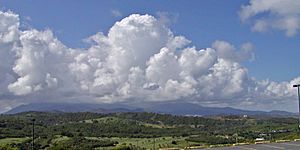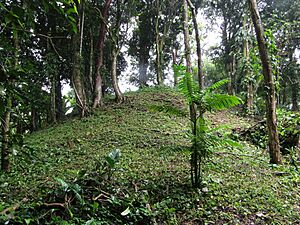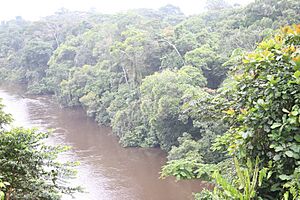Jungle facts for kids
A jungle is a type of forest with very thick and tangled plants. You usually find jungles in warm, wet places near the Earth's equator, called tropical climates. Over time, people have used the word 'jungle' to mean different things.
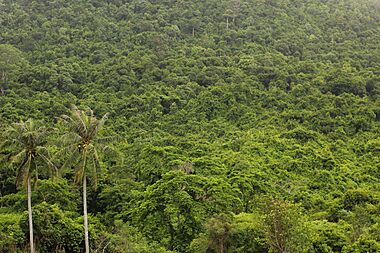
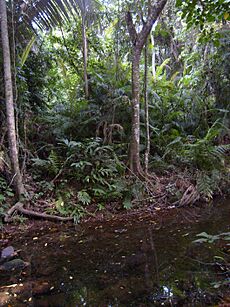
Contents
Where the Word "Jungle" Comes From
The word 'jungle' comes from an old Sanskrit word, jaṅgala, which meant 'rough and dry'. It came into the English language in the 1700s from the Hindustani word for forest.
Some people think that when the British were in India, they started using 'jungle' to mean a very thick, tangled forest. This word is common in many languages in places like India and Iran. There, it often describes new plant growth that takes over old forests or wild plants growing in places that people have left.
Animals and Plants in Jungles
Jungles are found all over the world where people live. They can include many different types of plants and land. Because of this, it's hard to give one simple description of all the wildlife you'd find in jungles. However, they are known for being home to a huge variety of animals and plants.
Different Ways People Use the Word "Jungle"
People use the word "jungle" in a few different ways.
When it Means Thick, Tangled Plants
One common meaning of 'jungle' is land that is completely covered with tangled plants close to the ground. This is especially true in warm, tropical areas. This kind of plant growth is so thick that it's hard for people to walk through. You often need to cut your way with tools.
This meaning of 'jungle' is different from a rainforest. In a rainforest, the plants on the ground are usually not very thick because not much sunlight reaches them. So, it's easier to walk through a rainforest.
Jungles can form inside or around tropical forests. This happens in areas where the forest has been opened up by natural events like hurricanes. It can also happen when people cut down trees. The new plants that grow back are often very dense and tangled, creating a "typical" jungle. Jungles also often grow along the edges of rainforests, like next to rivers, because there is more sunlight there.
Forests that have seasons, like monsoon forests, and mangrove forests are often called jungles. Monsoon forests have more open tops than rainforests. This means they have thick plants on the ground with many climbing vines and bushes, making it hard to move. Mangrove forests also have thick roots and low branches that make them difficult to get through.
When it Means a Moist Forest
Early European explorers often traveled through tropical forests by river. The very thick plants along the riverbanks made them think that the entire forest was like that. Because of this, they wrongly believed that all tropical forests were impenetrable jungles.
This led to a second popular use of 'jungle' to mean almost any humid tropical forest. When used this way, 'jungle' is often linked to tropical rainforests. But it can also mean cloud forests, temperate rainforests, and mangroves, without focusing on how thick the plants are or how easy it is to travel.
Since the 1970s, the terms "tropical forest" and "rainforest" have mostly replaced "jungle" to describe humid tropical forests. Before the 1970s, "jungle" was used over 80% of the time in print to talk about tropical forests. Now, "rainforest" is more common, but "jungle" is still used a lot for tropical rainforests.
When it's Used as a Metaphor
Sometimes, 'jungle' is used as a metaphor. This means it describes situations that are wild, messy, or where there are no rules. It suggests a place where only the strongest survive. This idea comes from how people in cities might imagine forests to be.
For example, the famous book The Jungle (1906) by Upton Sinclair was about factory workers in Chicago. It showed how they were treated unfairly, almost like they were in a wild place with no laws to protect them.
The phrase "The Law of the Jungle" is also used this way. It comes from Rudyard Kipling's book The Jungle Book (1894). In Kipling's story, the animals in the jungle actually followed a detailed set of rules. So, for Kipling, "The Law of the Jungle" meant a strict code of conduct, not a chaotic, lawless place.
The word "jungle" can make people think of wild, untamed nature that is far from cities. It can also bring feelings of danger, confusion, and being lost. The shift from using "jungle" to "rainforest" to describe tropical forests happened because people started to see these forests as delicate and special places. This new view didn't fit with the darker ideas that "jungle" often brought to mind.
See also
 In Spanish: Selva para niños
In Spanish: Selva para niños
- Monsoon forest
- Arid Forest Research Institute (AFRI)
- Rainforest
- Wilderness
- Grove (nature)
- Amazon rainforest


